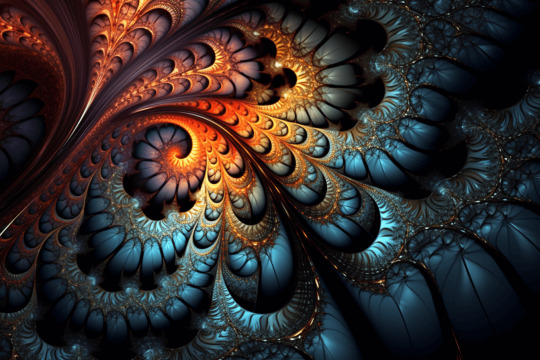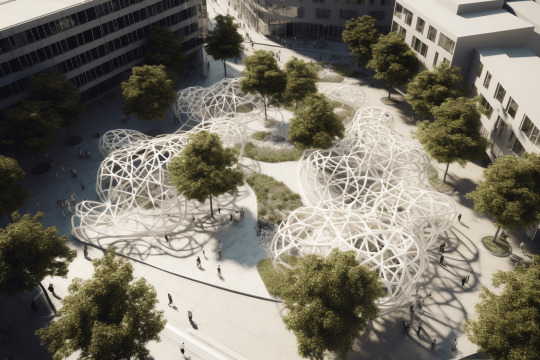#cellularautomata
Explore tagged Tumblr posts
Text
Generative Art: The Algorithmic Touch

Generative art represents an exciting merger of creativity and computation, where algorithms replace the brush, shaping intricate patterns and complex systems that transcend the bounds of traditional art forms. This unique form of art has a variety of methodologies at its disposal, from fractals to neural networks. This article explores these key algorithms and techniques that contribute to the world of generative art. Fractals A fractal is a self-similar shape that repeats infinitely at every level of magnification. The enchanting visuals they generate have long been a fascination for mathematicians and artists alike. Classic fractal types, like the Mandelbrot and Julia sets, exhibit stunningly intricate patterns and infinite complexity. More advanced constructs like 3D fractals or Mandelbulbs extend the concept to create highly complex three-dimensional works of art. Fractal-based algorithms leverage the recursive nature of fractals, making them an ideal tool in the generative artist's toolbox. Cellular Automata Cellular Automata (CA) is a discrete model studied in computational theory. A well-known example, Conway's Game of Life, consists of a grid of cells that evolve through discrete time steps according to a set of simple rules based on the states of neighboring cells. Through these rules, even from simple initial conditions, CAs can produce complex, dynamic patterns, providing a rich foundation for generative art. Noise Functions Noise functions such as Perlin noise or Simplex noise create organic, smoothly varying randomness. These algorithms generate visually appealing patterns and textures, often forming the basis for more complex generative pieces. From naturalistic textures to lifelike terrains, the randomness introduced by noise functions can mimic the randomness in nature, providing a sense of familiarity within the generated art. Genetic Algorithms Genetic algorithms (GAs) are based on the process of natural selection, with each image in a population gradually evolved over time. A fitness function, which quantifies aesthetic value, guides the evolutionary process. Over several generations, this method results in images that optimize for the defined aesthetic criteria, creating a kind of survival of the fittest, but for art. Lindenmayer Systems Lindenmayer Systems (L-systems) are a type of formal grammar primarily used to model the growth processes of plant development but can also generate complex, branching patterns that imitate those found in nature. This makes L-systems a powerful tool for generative art, capable of producing intricate, natural-looking designs. Neural Networks The advent of deep learning has opened up exciting new possibilities for generative art. Neural networks, such as Generative Adversarial Networks (GANs) and Convolutional Neural Networks (CNNs), are trained on a dataset of images to generate new images that bear stylistic similarities. Variations of these networks like StyleGAN, DCGAN, and CycleGAN have been instrumental in creating a broad range of generative artworks, from mimicking famous painters to creating entirely new, AI-driven art styles. Physics-Based Algorithms Some generative artists turn to physics to inspire their work. These algorithms use models of natural processes, like fluid dynamics, particle systems, or reaction-diffusion systems, to create pieces that feel dynamic and organic. Physics-based algorithms can produce stunningly realistic or fantastically abstract images, often emulating the beautiful complexity of nature. Swarm Intelligence Swarm Intelligence algorithms, like particle swarm optimization or flocking algorithms, simulate the behavior of groups of organisms to generate art based on their movement patterns. The collective behavior of a swarm, resulting from the local interactions between the agents, often leads to intricate, evolving patterns, creating compelling pieces of art. Shape Grammars Shape grammars constitute a method that starts with a base shape and then iteratively applies a set of transformation rules to create more complex forms. This systematic approach of shape manipulation allows artists to produce intricate designs that can evolve in visually surprising ways, offering a versatile tool for generative art creation. Agent-Based Models Agent-Based Models (ABMs) simulate the actions and interactions of autonomous entities, allowing artists to investigate their effects on the system as a whole. Each agent follows a set of simple rules, and through their interactions, complex patterns and structures emerge. These emergent phenomena give rise to a range of visually captivating outcomes in the realm of generative art. Wave Function Collapse Algorithm The Wave Function Collapse Algorithm is a procedural generation algorithm that generates images by arranging a collection of tiles according to a set of constraints. This algorithm has seen wide use in generative art and game development for creating coherent and interesting patterns or complete scenes based on a given input. Chaos Theory Chaos theory studies the behavior of dynamical systems that are highly sensitive to initial conditions. Art based on strange attractors, bifurcation diagrams, and other concepts from chaos theory can generate intricate and unpredictable patterns. These patterns, although deterministic, appear random and complex, making chaos theory a fascinating contributor to generative art. Ray Marching Ray Marching, a technique used in 3D computer graphics, is a method of rendering a 3D scene via virtual light beams, or rays. It allows for the creation of sophisticated lighting effects and complex geometric shapes that might not be possible with traditional rendering techniques. Its flexibility and power make it an attractive option for generative artists working in three dimensions.
Conclusion
The intersection of art and algorithms in the form of generative art enables artists to explore new modes of creation and expression. From fractals to neural networks, a variety of techniques provide generative artists with powerful tools to create visually captivating and complex art forms. The dynamic and emergent nature of these algorithms results in artworks that are not just static images but evolving entities with life and movement of their own. Read the full article
#cellularautomata#fractals#generativeart#GeneticAlgorithms#L-Systems#Neuralnetworks#NoiseFunctions#Physics-BasedAlgorithms#RayMarching#SwarmIntelligence
0 notes
Text
Evasion. Caldera
Imprecise view from the caldera

https://objkt.com/asset/KT1Bd32N6WQZPzHXvtXgLjHFWwPoXJ13bd35/10
0 notes
Photo

CA (2016) | with @materialarchitecturelab . . . #architecture #cellularautomata #architecturelovers #designboom #digitalart #art #architecturehunter #next_top_architects #designboom #architizer #arqsketch #arc_only #archdaily #archilovers #architectureape #architecturedose #3d #motiongraphics #motiondesigner #architecturestudent #superarchitects #architectureschool #iarchitectures #arquitectura #instaarchitecture #synarchitecture #danielwidrig https://www.instagram.com/p/Brxz-JVBhwm/?utm_source=ig_tumblr_share&igshid=ct8ks8m6z0jo
#architecture#cellularautomata#architecturelovers#designboom#digitalart#art#architecturehunter#next_top_architects#architizer#arqsketch#arc_only#archdaily#archilovers#architectureape#architecturedose#3d#motiongraphics#motiondesigner#architecturestudent#superarchitects#architectureschool#iarchitectures#arquitectura#instaarchitecture#synarchitecture#danielwidrig
1 note
·
View note
Photo

A cell communicates and works with its neighbour. It can assume one of several roles at a time. Once in a while, it can morph into another type of cell to remain relevant in its organism; and for the organism to keep meaningful and functional. #cellularautomata #ca #cann #neuralnetwork #neuralnetworks https://www.instagram.com/p/Bs-hu0GgEm3/?utm_source=ig_tumblr_share&igshid=17vswvf9lcal6
0 notes
Text
Algorithms for Eco-Friendly Urban and Architectural Planning

As the world faces an increasing number of environmental challenges, architects and urban planners are searching for innovative solutions to create sustainable, eco-friendly spaces. One promising avenue is to harness the power of generative art algorithms based on natural patterns and processes. By mimicking the intricate designs found in nature, these algorithms offer a new approach to environmentally responsible urban and architectural design.
Generative Art Algorithms: Nature's Blueprint
Generative art algorithms are mathematical and computational processes that simulate the organic growth and development of natural forms. These algorithms often employ fractals, cellular automata, agent-based models, and artificial life systems to create complex, evolving patterns that mirror the beauty and efficiency of nature. - Fractals: Fractals are self-similar patterns that repeat at different scales. They are prevalent in natural phenomena such as tree branching, snowflakes, and coastlines. Fractal algorithms can help architects create space-efficient, structurally sound designs that minimize waste and material usage. - Cellular Automata: Cellular automata are discrete models that simulate the behavior of complex systems through a grid of cells. Each cell follows a simple set of rules, which results in large-scale patterns and structures. This can help urban planners design adaptable, resilient cities capable of responding to environmental changes. - Agent-Based Models: Agent-based models use individual agents, each with their own set of rules, to simulate the interactions and collective behavior of a system. These models can be applied to urban planning to optimize transportation systems, pedestrian movement, and resource distribution. - Artificial Life Systems: Artificial life systems mimic biological processes, such as growth and reproduction, to create evolving forms. These algorithms can help architects design buildings that adapt to their environments and respond to changing conditions.
Generative Art Algorithms in Urban and Architectural Planning
By employing generative art algorithms, architects and urban planners can create spaces that are not only aesthetically pleasing but also environmentally friendly. Some key applications include: - Sustainable Resource Management: Generative algorithms can optimize the use of natural resources such as sunlight, wind, and water, reducing a building's energy consumption and environmental footprint. - Green Infrastructure: These algorithms can inform the design of green roofs, walls, and other living architecture elements, which not only enhance aesthetics but also improve air quality, reduce urban heat island effect, and support local biodiversity. - Adaptive Urban Design: Cities can be designed to respond dynamically to environmental changes, promoting resilience and sustainability. Generative algorithms can help planners create adaptive transportation systems, decentralized energy grids, and efficient resource distribution networks. - Material Efficiency: Generative art algorithms can help minimize material usage and waste during construction by optimizing structural designs and promoting the use of local, sustainable materials. - Biophilic Design: By incorporating nature-inspired patterns, generative art algorithms can create spaces that promote human well-being and productivity, while fostering a stronger connection between people and the natural world.
Conclusion
The convergence of generative art algorithms and eco-friendly urban and architectural planning has the potential to reshape the way we design and inhabit our cities. By embracing nature's wisdom and creativity, we can create spaces that are not only aesthetically pleasing but also sustainable, resilient, and harmonious with the environment. As our understanding of these algorithms continues to grow, we can expect to see even more innovative applications that will help us build a greener, more sustainable future. Read the full article
#agent-basedmodels#architecturaldesign#artificiallifesystems#biophilicdesign#cellularautomata#eco-friendly#fractals#generativeartalgorithms#greeninfrastructure#urbanplanning
9 notes
·
View notes
Text

4 notes
·
View notes
Video
instagram
#abstractvideo #cellularautomata #coral
1 note
·
View note
Audio
Dopplereffekt Von Neumann Probe (2017)
From the album: Cellular Automata (Leisure System)
#dopplereffekt#cellular automata#von neumann probe#leisure system#cellularautomata#vonneumannprobe#leisuresystem
0 notes
Photo

#cellularautomata woven 1:1 on a jacquard loom #computationaltextiles at #purecountryweavers
0 notes
Photo

#Mono in #CellularAutomata #form. "#Crowns on #Velvet"
0 notes
Video
instagram
mazeInfect_1.mov #Processing #cellularAutomata (at Los Angeles, California)
3 notes
·
View notes
Video
vimeo
zero 2
0 notes
Photo

Art by @jazergiles hue-ey loose . . . . . #andthenews#cellularautomata#sandpile#geometry#triangle#cube#glitchart#digitalart#l#landscape#abstractlandscape#mountains#abstractmountains#algorithmicart#generativeart#computerart#artistsoninstagram#pixelsorting#jitter#maxmsp#cycling74#c74connect https://www.instagram.com/p/Ccj0ZCiDKO7/?igshid=NGJjMDIxMWI=
#andthenews#cellularautomata#sandpile#geometry#triangle#cube#glitchart#digitalart#l#landscape#abstractlandscape#mountains#abstractmountains#algorithmicart#generativeart#computerart#artistsoninstagram#pixelsorting#jitter#maxmsp#cycling74#c74connect
0 notes
Text
Process
My body of work consists in defining an environment and how the elements it contains are going to act inside this framework. Thus it’s first of all, a question of fixing rules which will produce, as parameters, several behavioral patterns. This organisation generates particular shapes, patterns, textures (hatching weaving) and movements. I use cellular automata for this, i.e. system of computation which will define the configuration and interaction of each pixel of my canvas.
1 note
·
View note


